Sprint Retrospective Examples For Scrum
If you're leading a Scrum team, performing regular sprint retrospectives is an essential task.
Before you do this, it will be beneficial to look through some sprint retrospective examples!
The general purpose of a sprint retrospective is to reflect on the sprint and collect valuable feedback from the team. This can benefit and inform future sprints!
Sprint retrospectives encourage teamwork and collaboration, and give everyone on the team a voice. When run well, these meetings can have a positive impact on the efficiency of any Scrum project.
Not sure where to get started? This guide will run you through some of the best sprint retrospective examples out there.
What Is A Sprint Retrospective?
Scrum projects are made up of different phases. These phases are divided up into sprints.
A sprint retrospective is a meeting wherein the team reflects on their performance in the sprint. These meetings are held after each sprint, to collect valuable feedback from the team.
These meetings help teams establish what went well, what held the team back, what successes the team is proud of, and what they should take note of going forward into the next sprint.
The point of running a sprint retrospective is to identify possible pitfalls and help the team start the next sprint on the right foot. This is essential for making the next sprint more productive.
Sprint retrospectives work by getting the entire team together to discuss their ideas and opinions. Gathering feedback from the whole team gives everyone a voice and helps to get everyone on the same page.
There are many sprint retrospective examples out there. While sprint retrospectives all follow the same general idea, the different ways that these retrospectives are discussed and mapped out differ.
Elements Of A Sprint Retrospective
No matter what type of sprint retrospective examples you look at, these processes all follow the same general format.
Here are some key elements that most sprint retrospectives include:
- What went well: The team should discuss the successes of the sprint and agree on some of the things everyone did well. This should involve identifying what helped the team move forward.
- What did not go well: The team should discuss what held them back during the sprint or any possible issues that should be considered before heading into the next sprint.
- Positive achievements: What made each team member feel good during the sprint? This can help boost motivation.
- Potential risks: What possible future risks still exist that the team needs to be aware of going into the next sprint?
While each retrospective meeting can look very different, these are the main ideas that are usually covered.
The agenda for the meeting, and what is discussed, should be in line with the goal of the meeting. What feedback is useful and necessary for the team to move forward? What is important for the team to discuss?
Why Is The Sprint Retrospective So Important?
When working on a project in agile, running a sprint retrospective is an essential task for teams to perform.
While it may seem like a boring task for busy teams, teams must take retrospectives seriously and put enough time and effort into them. A well-run sprint retrospective offers many benefits to the team.
Here are some of the main reasons why running a sprint retrospective is beneficial to project teams.
1. Identifies Issues
Possibly the main advantage of running a sprint retrospective is that it helps team members identify any potential problems early on.
This means that the team can identify any possible conflict areas, and resolve them before they become major issues later on in the project.
This means that teams can consistently improve their processes by evaluating any pitfalls that are holding them back. The result of this is more efficient work with fewer roadblocks along the way.
2. Keeps The Project On Track
Sprint retrospectives are a critical function to help project managers keep things running smoothly. The point of performing retrospectives is to evaluate the overall successes and challenges of a sprint. This lays the foundations for the next sprint.
Retrospectives help to keep the overall project on track and ensure that each sprint is more efficient than the last one.
Formally closing each sprint with a retrospective lets team members start each sprint on a new page, with clarity on how they should operate to achieve better results going forward.
3. Gathers Feedback
Sprint retrospectives are all about getting the team together to share their feedback, insights, and ideas. This is essential for solid team collaboration.
It also gives everyone on the team a chance to share their views on the project.
Retrospectives encourage active participation within a team. They also encourage the team to adopt a more collaborative approach when working on a project. This can help the team solve issues faster.
4. Strengthens The Team's Spirit
Sprint retrospectives are not only about identifying problems. They also celebrate wins!
Getting the team together to discuss all of a project's successes and achievements can help the team feel more excited about their work. This is a great way to boost team spirit and morale.
When teams understand their successes and can celebrate them, they will be more motivated to continue achieving success as the project develops.
5. Identifies Small Changes
Instead of only looking at the big picture, sprint retrospectives help teams to identify the small changes that end up making a major impact on the overall project.
This helps teams realize the small steps they can take to achieve greater success.
Having each team member find room for improvement is a great way to encourage and develop their sense of ownership over their work. Each team member can use retrospectives to connect with the project and grow their understanding of their role.
6. Gives Teams More Power
When you run a sprint retrospective, the whole team gets together to share their ideas and opinions. This ensures that the whole team is heard and feels as though their opinions matter.
This process helps team members recognize that each role is important. After all, each role in a team holds equal weight!
If each member of the team is more motivated and feels more power in their role, then the team will perform better as a unit.
Sprint retrospectives also help to improve communication within teams, making it easier for each team member to raise concerns when they need to.
Sprint Retrospective Examples
Sprint retrospectives tend to follow the same basic framework. Although this can be adjusted to fit different teams and projects.
It's important that the retrospective framework and tools you use help your team get the most from the process.
Here are some sprint retrospective examples that could help you out with your next scrum project.
Sprint Retrospective What Went Well Examples
When looking for sprint retrospective ideas, what went well examples are some of the most useful to look at.
This type of retrospective is a vital part of running a project. Basically, it helps teams examine what went well in the previous sprint to boost the success of the sprint ahead.
When working on a what went well retrospective, it's recommended that teams create action items that they can use for the next sprint.
This type of retrospective isn't only for agreeing on previous successes. It's a way to understand these successes so that they can be used to ensure successful future sprints.
When running this kind of sprint retrospective, it's also useful to also include a what didn't go well section. This makes it easier for teams to compare successes and issues, which can help the retrospective to be more actionable and impactful.
It's a good idea to set a time limit when creating this retrospective (usually around 30 minutes) so that the team can comfortably discuss these issues and move forward without wasting time.
Simple What Went Right Comparison
Here is a very basic example of a what went well sprint retrospective:
 Source
Source
This example is simple and straightforward but is still highly impactful for Scrum teams. The team can simply jot down their main successes and challenges on an interactive board, and compare them directly alongside each other.
This is useful for finding an actionable way forward to achieve the team's goal.
The Sailboat technique
 Source
Source This fun sprint retrospective template follows a sailboat theme. The what went well section is depicted as the wind that pushes the sailboat (the team) forward. The what didn't go well section is depicted as the anchor holding the team back.
This template also includes what made the team feel good (the sun) and what future risks lie ahead (the reef). All of this comes together to paint a complete picture of how the team can reach its sprint goal (the island).
Visually depicting sprint retrospectives like this is a fun way to understand the impact of the different elements involved in the meeting. In each case, the points that the team brings up are displayed in different colored squares within the image.
When you put all of the elements together, the team can gain an actionable understanding of the steps that need to be taken in the next sprint to enhance its success.
Feedback Grid
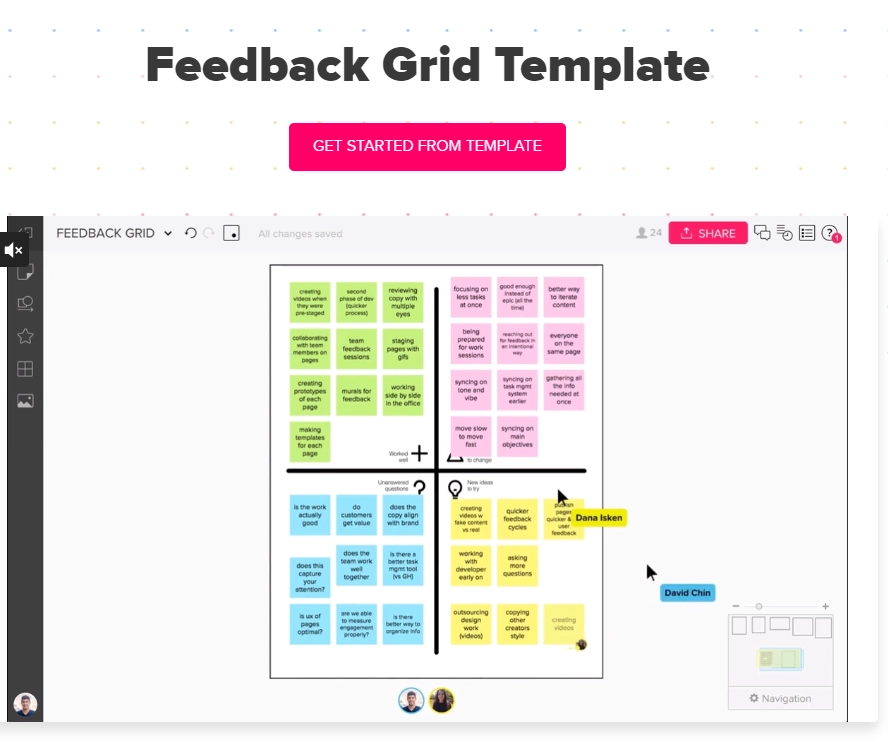 Source
Source This template breaks the sprint retrospective up into four sections:
- Worked well
- To change
- Unanswered questions
- New ideas to try
The interactive board lets team members drag and drop their ideas onto the different sections of the board.
Instead of just listing ideas on what went well during the sprint, a layout like this helps teams easily compare these ideas with each other.
A great feature of this is identifying what worked well and then using this information to establish new ideas to try. This helps to make the retrospective more actionable for the sprint ahead.
Of course, the board also looks at things to change (what didn't go well) and unanswered questions that could lead to potential issues going forward.
This is a simple retrospective example, but it can help teams gain a lot of valuable information for the upcoming sprint. By making use of these feedback tools, teams can boost their productivity in a big way.
Sprint Retrospective What Went Wrong Examples
Understanding the sprint retrospective what didn't go well examples is critical for any successful retrospective meeting.
This is because you need to identify mistakes and issues at the end of a sprint to ensure you don't make those same mistakes again. The more easily you can pick up on these problems, the more successful the sprint ahead will be.
As mentioned earlier, this should be compared to the successes of the sprint. By understanding what went well and what went wrong, it's easier to understand how to improve the sprint ahead.
One of the most common sprint retrospective examples is the start, stop, and continue framework.
Start, Stop, And Continue Framework
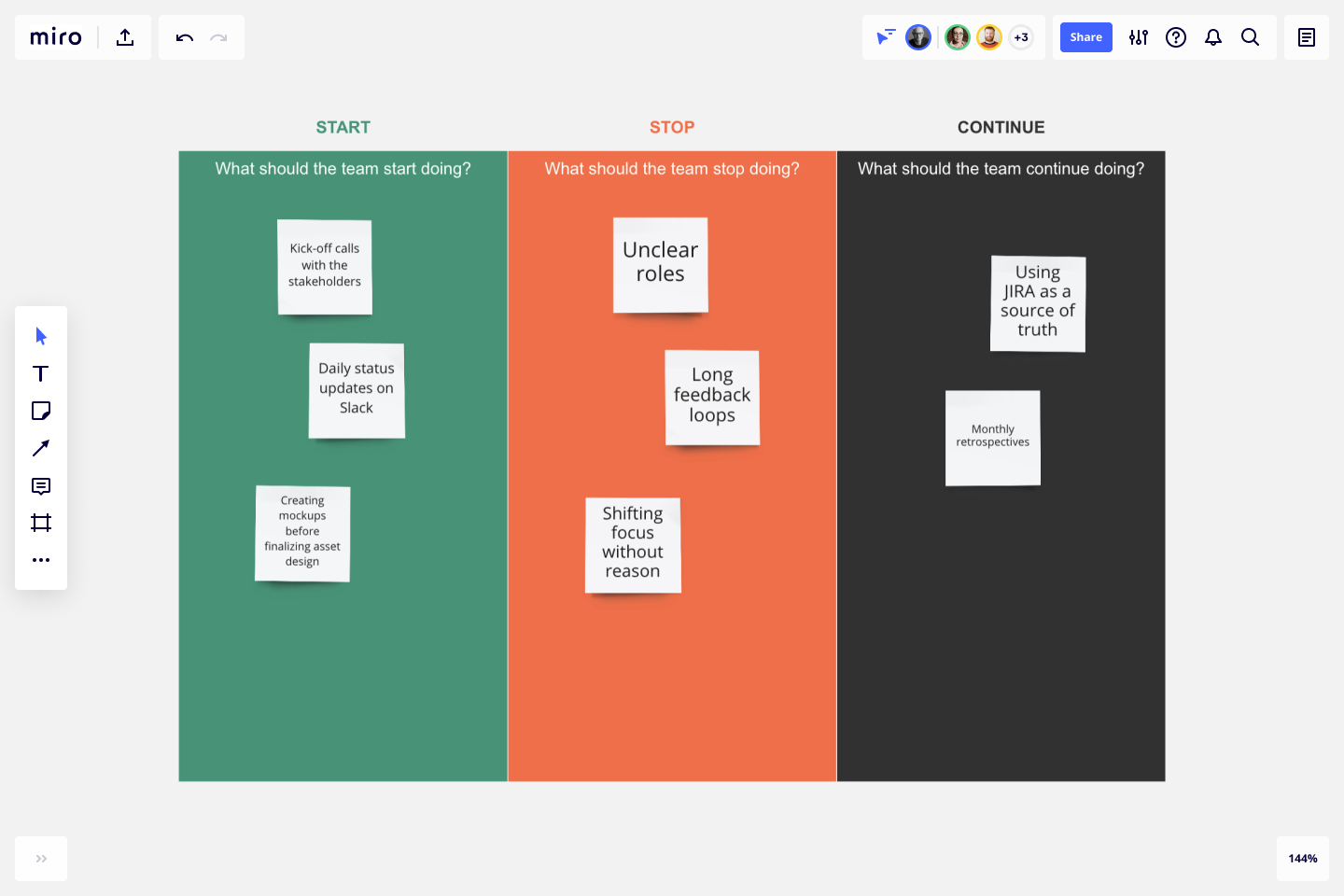 Source
Source This retrospective takes into account the what went wrong aspect by highlighting what the team should stop doing.
This is compared to what the team should start doing to solve these issues, and what the team should continue doing to keep on seeing good results.
It's a very simple framework because it only requires teams to make three decisions, all of which are highly actionable. This means teams can move on to the next sprint knowing exactly what they will be working on and what changes they should make to optimize their performance.
Three Little Pigs
Here's a clever sprint retrospective example that looks into the different things that went wrong (or could cause a risk) during a sprint:
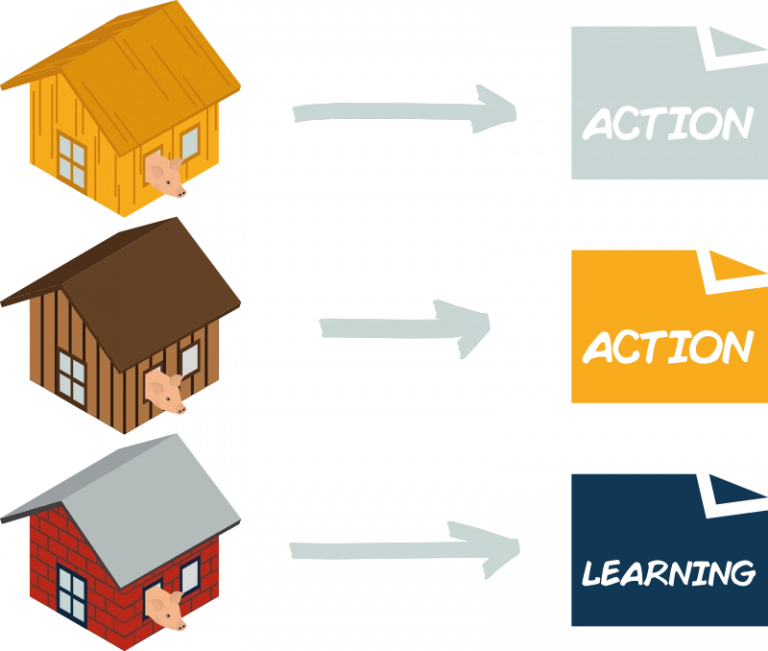 Source
Source The retrospective represents the three little pigs and their houses made from straw, wood, and brick. The straw house is used to identify the biggest issues that could present themselves at any time.
The wood house identifies minor issues that could use improvement. The brick house represents the successful and stable parts of the project that don't require any change.
This is a great way to visualize what's going well and what isn't. Teams can compare these different elements with each other for a clearer overview of the project's status.
Most importantly, this retrospective example helps you create a list of action items that went wrong and a learning list from what went well.
This means you don't only flag issues in this type of retrospective, but you use these issues to create an actionable solution for the sprint and tasks ahead.
Simple What Went Wrong Comparison
Finally, here's a super simple example of a what went wrong sprint retrospective:
 Source
Source This type of retrospective is ideal for simply laying out what's working and what isn't. This can help Scrum teams optimize their project performance with each retrospective.
Being able to clearly compare what is and what is not working is a great way to see how the team is performing. This will show what kind of changes need to be made before going into the next sprint.
Sprint Retrospective What Could Be Improved Examples
Some sprint retrospective examples make a point of understanding what to improve over what went wrong.
While it's a similar approach, this retrospective viewpoint is less about pinpointing the things that went wrong, and more about understanding how to improve the sprint process.
Taking a what could be improved approach is a lot more actionable than just pointing out issues that were experienced.
As always, it's important to compare your what could be improved ideas against what already works. This will help your team to understand how to keep their sprints successful!
Stickies.io Retrospective Framework
Here's a straightforward sprint retrospective example:
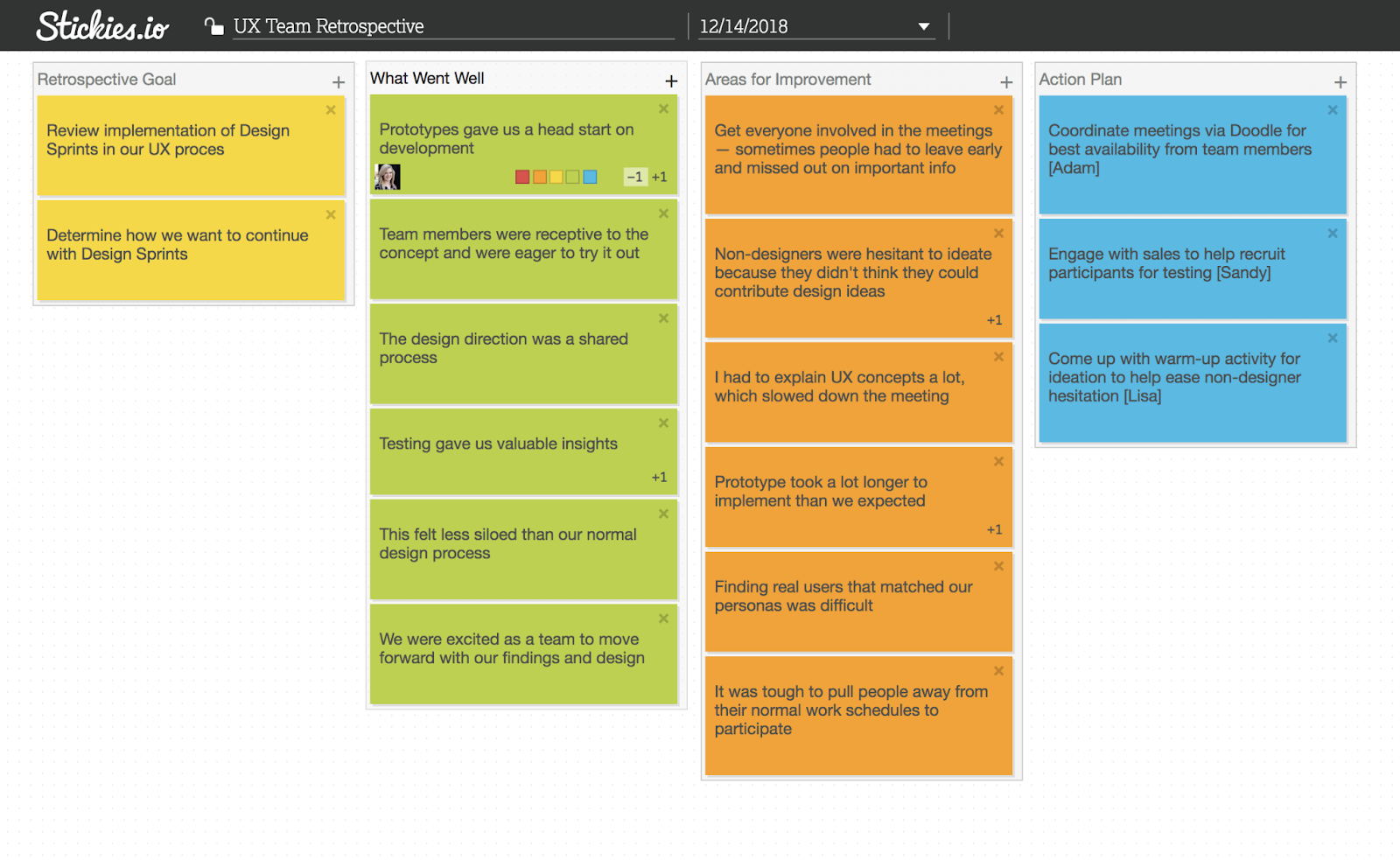 Source
Source This framework depicts a very standard format for any sprint retrospective. The board includes the sprint goal, what went well, and what needs to be improved. This is tied together into an action plan.
Although it's simple, this is one of the best sprint retrospective examples.
It helps teams create a clear flow of actions from the goal of the sprint to the execution of the next sprint.
By assessing what went wrong and what went well, teams can understand what to address in their next sprint.
By looking at what went wrong as a list of areas for improvement, teams can understand how to move forward without focusing too much on the negatives.
This board should be interactive and adjusted by team members as the sprint progresses.
Mountain Retrospective
Here's another good example:
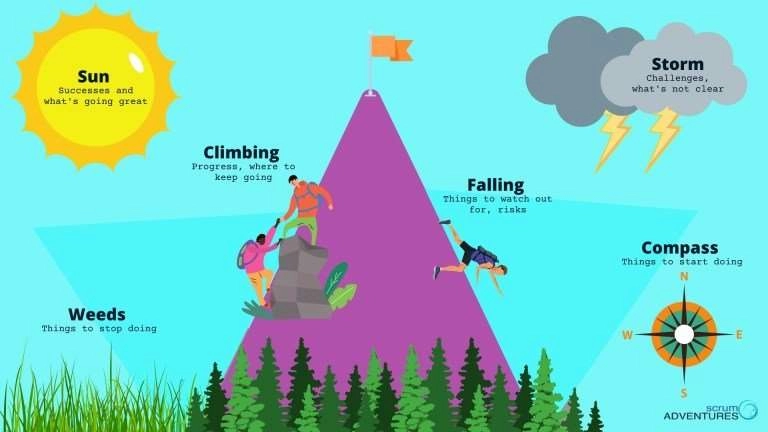 Source
Source This hiking-themed retrospective is a really fun one, and not just because of the graphic! This is a very detailed retrospective example.
Teams can establish potential improvements by adding to the ‘falling' section (risks - things to watch out for) and the ‘storm' section (challenges - anything that's not clear).
These are two different types of issues that are highlighted to provide a more insightful overview of the sprint.
This example also establishes things to stop doing (weeds), things to continue doing (climbing), and successes from the sprint (sun).
All of these different elements come together to paint a great overview of how the sprint went and what can be improved for the next one.
Hot Air Balloon
Here is one more fun example:
 Source
Source This retrospective includes three main elements:
- Sunny days: Things that are going well, successes, and anything moving the project forward.
- Storm: Difficulties, pitfalls, or risks the project is facing.
- Sandbags: Things that are holding the project back.
This fun hot air balloon diagram brings these three elements together to answer the questions of what is going well and what can be improved.
Unlike other sprint retrospective examples, this one only includes three ideas, but these three ideas come together to form a very detailed overview of the sprint.
This tool is a great way to understand the sprint better. It also helps teams to gain some actionable insights on how to move the next sprint forward in a more efficient way.
This is why this example is not only retrospective but also futurespective.
Sprint Retrospective Action Items Examples
There are loads of different sprint retrospective examples and formats that you can use.
While these are all good for understanding how the previous sprint's performance went, the most important thing is that you can use these insights to improve the next sprint.
The overall goal of retrospectives is to help teams achieve better performance as the project progresses.
To do this, you'll want to use sprint retrospectives that uncover actionable tasks.
Action items are uncovered when the retrospective considers the previous sprint and uses this to create specific feedback that can be used going forward.
CareerPrep Retrospective Framework
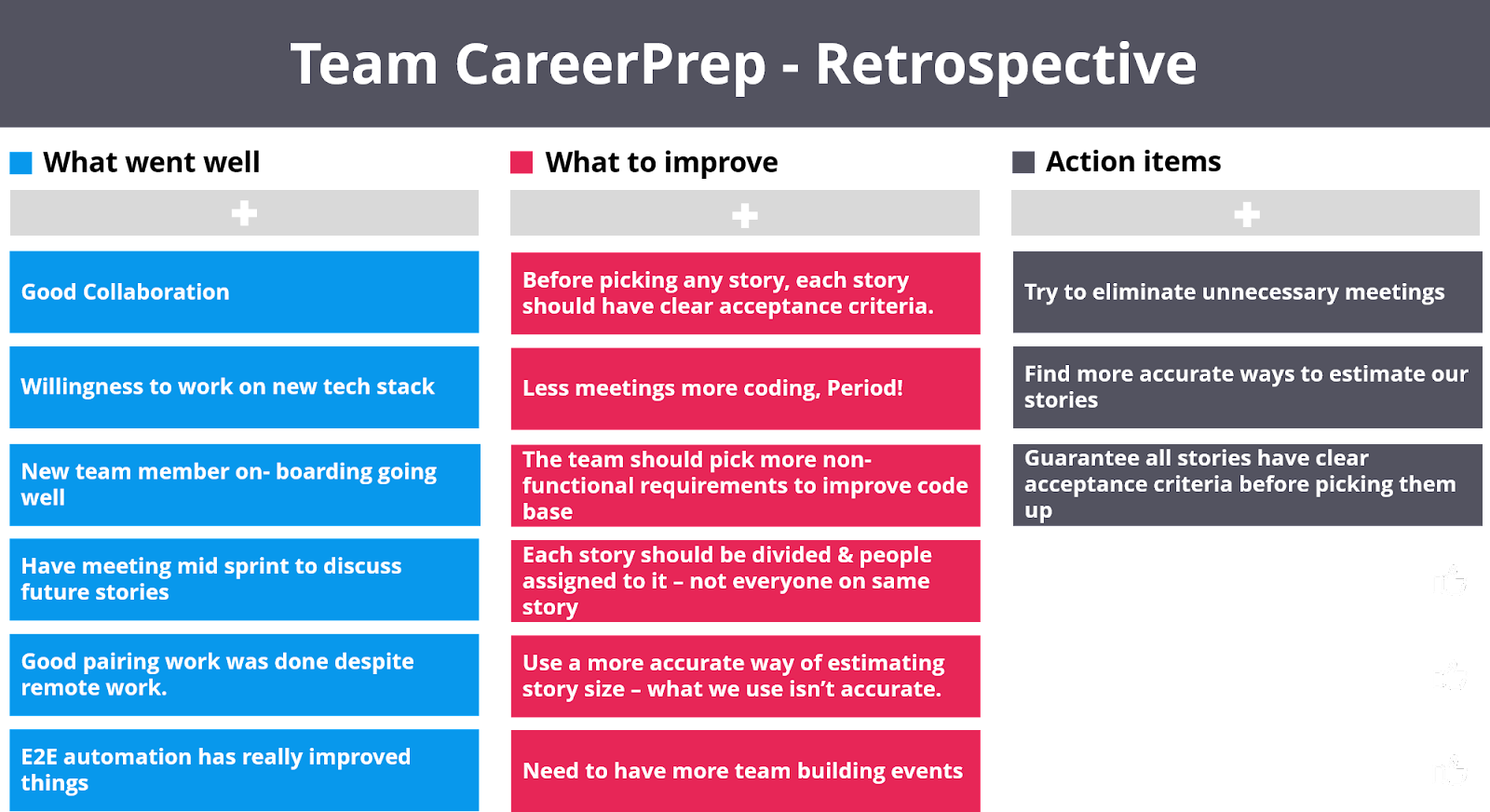 Source
Source Like many sprint retrospective examples, this one starts by defining what went well and what to improve. The board then takes this further by including an action item section for each point.
This creates a very clear framework for how the team can move forward into the next sprint and avoid making the same mistakes or issues again.
The more action items the sprint includes the more value the sprint will generate. This framework is great for teams looking to integrate their feedback into their work plan!
You can apply this idea of an action item to any other sprint retrospective example. The important thing is that you include an action item point before moving on to the next sprint!
WRAP Sprint Retrospective Examples
WRAP is another useful approach to performing a sprint retrospective.
WRAP stands for Wishes, Risks, Appreciations, and Puzzles. Breaking up a retrospective into these four areas can provide some helpful insights.
 Source
Source Wishes are anything the team wants to improve on based on their previous sprint experience. These can be milestones that need to be achieved or ideas that come from problems the team faced.
Risks are any issues that might hold the next sprint back. Understanding these is important for creating solutions and plans to head into the next sprint.
Appreciations are anything the team is happy about from the previous sprint. Taking the time to establish appreciation can do a lot for boosting team morale, as well as helping the team understand what areas they can continue to focus on.
Puzzles are any unanswered questions or concerns the team may have. If anything is going on that the team has yet to figure out, it can be added to the puzzle section.
Combining all of these areas helps teams understand which path is the best way forward for the next sprint.
Sprint Retrospective Feedback Examples
Much like sprint retrospective examples focused on creating action items, these types of retrospective frameworks generate feedback from the team.
They're not just about creating an overview of the sprint, but rather about establishing what the team did well, what they didn't do well, and how they can improve things.
The 4 Ls
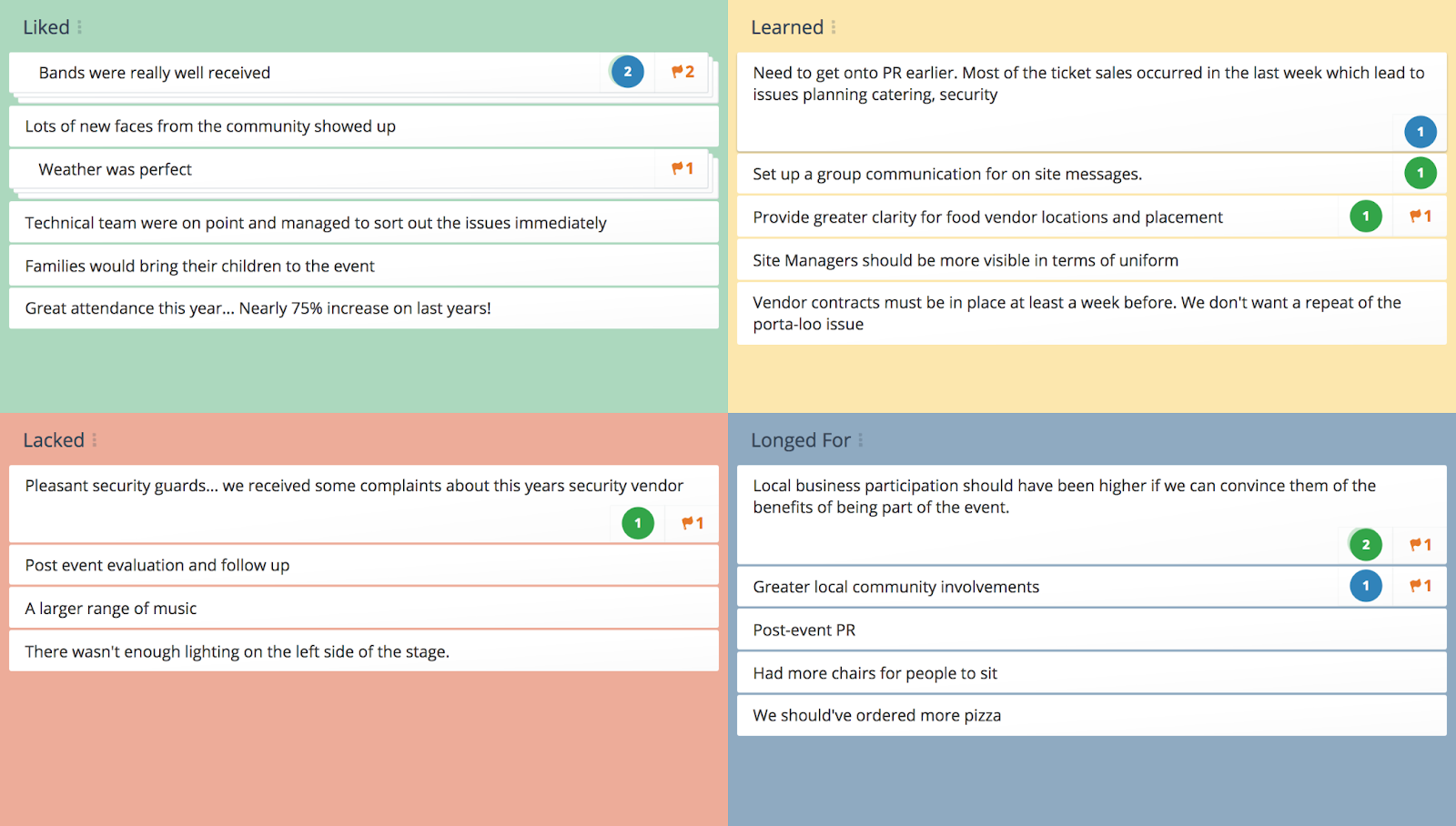 Source
Source These Ls are:
- Liked: What the team enjoyed about the previous sprint. These are all things that can be continued into the next sprint.
- Learned: Any lessons gained from the sprint. This can help teams establish what to avoid going forward.
- Lacked: Any areas that were missing in the sprint. This can help teams understand what they need to do going forward.
- Longed For: Any issues the team faced that they would have liked to have fixed in the sprint. This can help teams understand what they should include in the next sprint.
These four Ls can be slightly more personal for each member of the team.
By getting each person involved in the sprint to contribute their ideas to this, you can create a detailed and useful retrospective to help guide the next sprint more efficiently.
When To Choose The Right Sprint Retrospective
These different sprint retrospective examples are all designed to help teams understand the previous sprint and optimize the next one.
However, they all take a very different approach and can all be applied to very different scenarios.
You must choose your sprint retrospective framework carefully, based on the team, how they're performing, and what needs to be improved.
For example, some teams may need a boost in team morale. In this case, it's good to include a retrospective that outlines successes and puts focus on what the team is happy about.
Some teams are highly efficient and straightforward, and may just need to establish some action items for optimizing the next sprint. In this case, a simple 3-step action item sprint could work well.
Always keep the sprint and project goals in mind when doing a retrospective to ensure every detail included in the retrospective is relevant.
Final Thoughts
We hope you've discovered some useful sprint retrospective examples in this article!
Before you move on to a new sprint, it's always a good idea to run a retrospective for the previous one. This ensures that the team is on the best path forward, and is on the same page.
Sprint retrospectives can help teams gain all kinds of insights, which is important for continually improving the team's performance. Get this right, and each project should be easier to manage, as well as more efficient!
Create a free retrospective for your team

